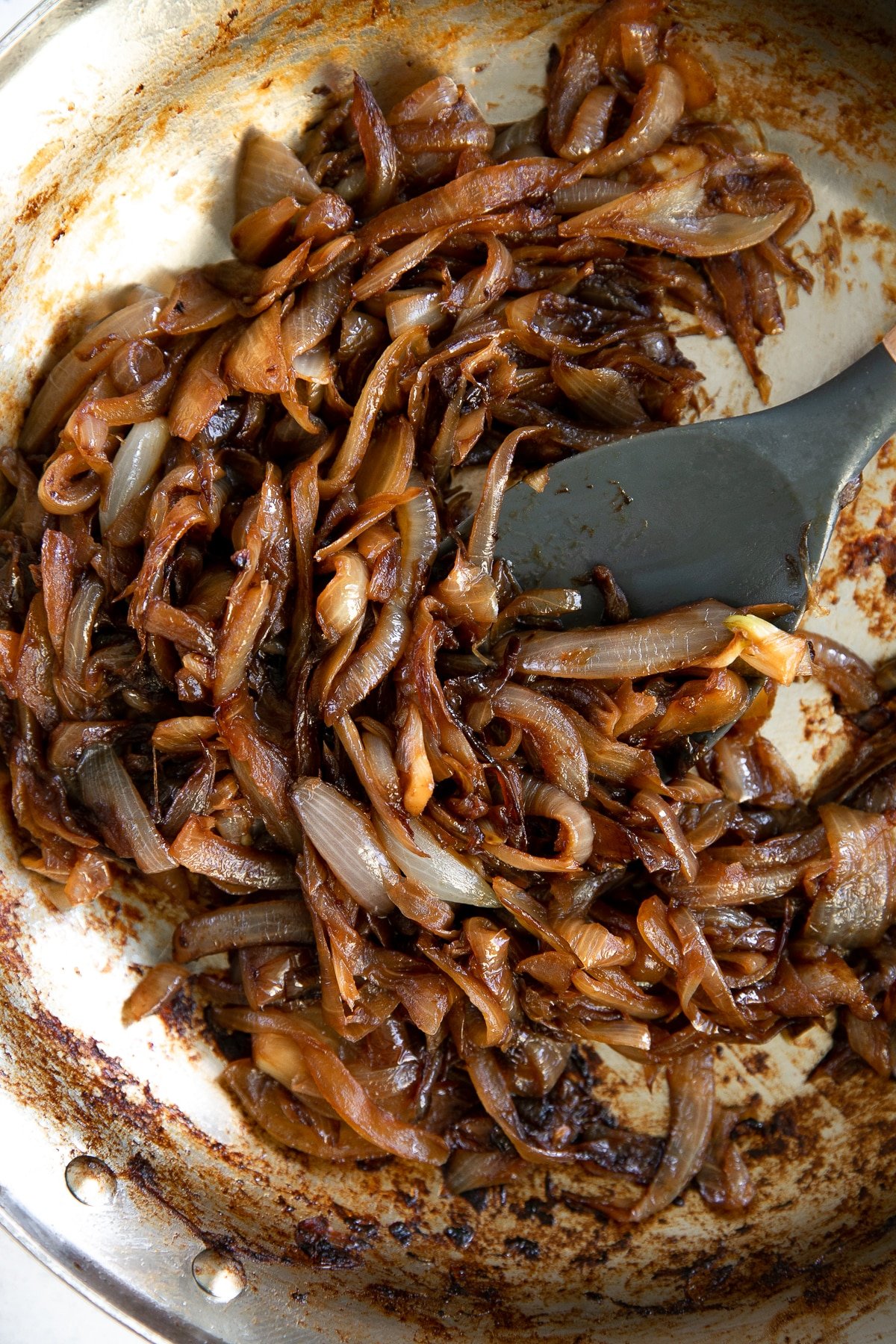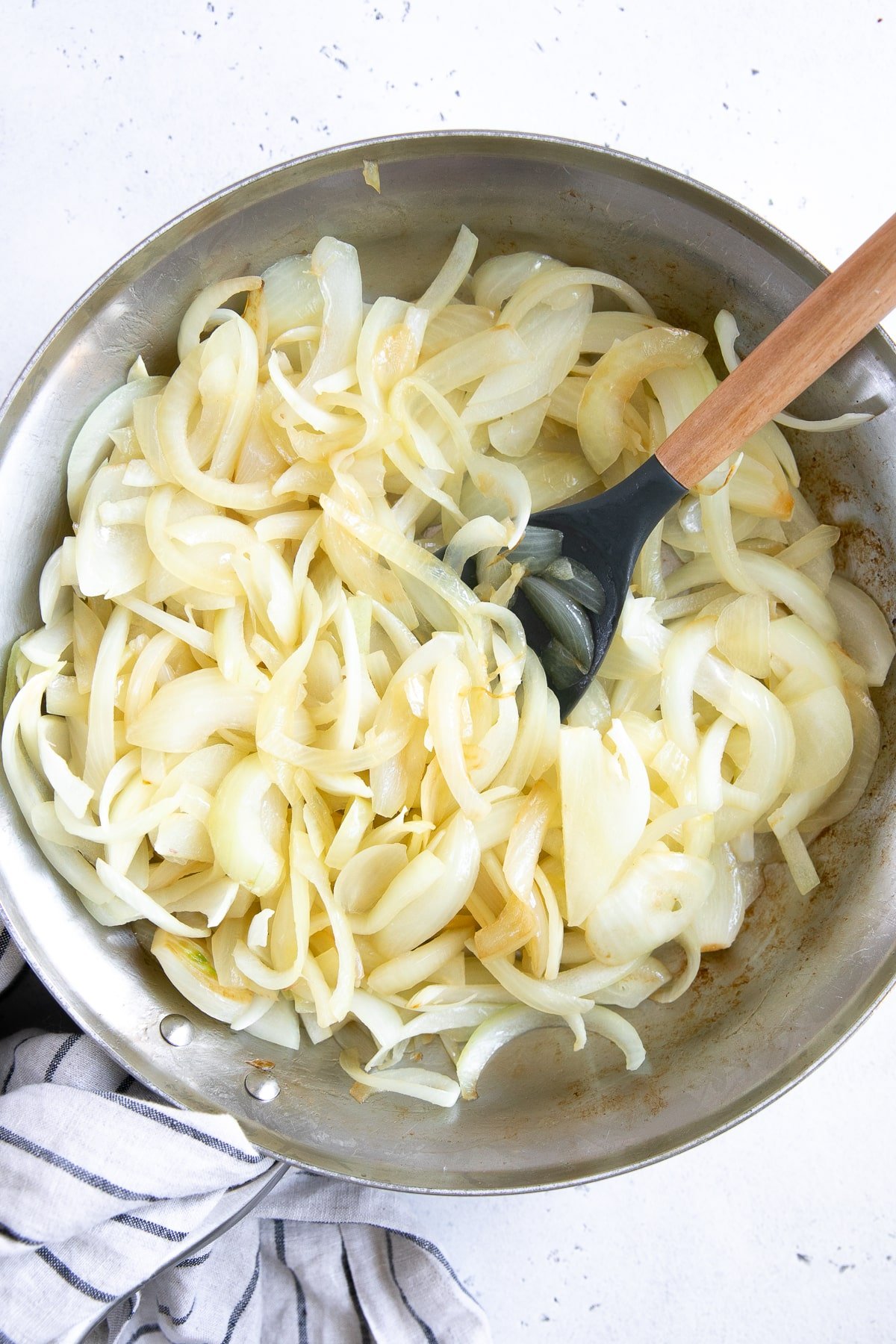This post may contain affiliate links. See my disclosure policy.
Caramelized onions are made by cooking onions low and slow until golden, delicious, and intensely flavorful. Learn how to caramelize onions with this easy step-by-step tutorial and enjoy them on burgers, sandwiches, in soup, or tossed in your favorite salads.

You’ll use them to make onion soup and onion dip, to top your favorite hamburgers and pizza or added to rice and grains for extra flavor. But how, exactly, does one make caramelized onions? Believe it or not, making caramelized onions is super easy. In fact, all they require are some onions, olive oil, butter, salt, and time.
Table of Contents
How Long Does it Take to Make Caramelized Onions?
It takes about 45-60 minutes to cook caramelized onions. It’s a long process, but well worth the wait.
Why does it take so long to caramelize onions?
To draw out the natural sugars found in onions (those which are responsible for caramelization), the onions must be cooked at a low temperature for a long period of time. Cooking at a higher heat or attempting to “rush” the process, will cook off the moisture too quickly, preventing the sugars from being drawn out properly, ultimately resulting in burnt, flavorless onions.

How to Caramelize Onions
1. Prepare the onions:
Use a sturdy knife to slice 1/2-inch off from the stem and root end of each onion. Cut the onions in half, stem to root, and peel. Place the onions cut-side-down and cut, again from stem to root, into slices approximately 1/4 to 1/2-inch thick. Repeat with all onions.
Best onions for caramelizing?
Just about any onions will work, but Vidalia onions or white onions are my top picks.

2. Start cooking the onions: Set a large, heavy-bottomed pan or cast-iron skillet over medium heat. Add the olive oil and butter and swirl to coat the bottom of your pan. Add the sliced onions, mixing to coat the onions in butter and oil.
3. Continue cooking the onions:
Allow your onions to cook, stirring occasionally. If the onions start to brown, immediately reduce heat to medium-low heat. After about 10 minutes, sprinkle with a pinch of salt and stir to combine. By this point, your onions should be softening and lightly golden.
Tip
If the onions start to dry out or brown/burn prematurely (assuming your heat is already set to medium-low), add a few teaspoons of water to the pan.

4. Continue to cook, stirring often:
Continue to cook for an additional 30-45 minutes, stirring every 2-3 minutes to prevent them from burning. Avoid stirring continuously. Stir just enough to allow the onions to cook and stick to the bottom of the skillet, browning just slightly – but not burning. If you stir too often, they won’t brown. If you don’t stir often enough, they will burn.

5. Use a metal spatula to scrape the pan often:
After about 30 minutes, your onions should be a rich golden color. Use a metal spatula to scrape up the brown bits from the bottom of your skillet. Continue to cook, stir, and scrape the brown bits (fond) from the bottom of the pan until your onions are a dark rich golden brown color.
What is fond?
Fond is the sticky brown bits stuck to the bottom of your skillet. To prevent the fond from burning, make sure the heat is set to a temperature low enough to prevent the onions from burning. Also, use a metal spatula to scrape the bottom of your pan every 1-2 minutes and, if necessary, deglaze your pan with a bit of water.

Tips & Tricks
- Turning up the heat won’t caramelize your onions faster. Don’t rush it, caramelizing onions is a science.
- Do not walk away from your onions. Unlike the slow cooker or Instant Pot, you need to remain proactive when caramelizing onions. This is especially important in the second half of cooking when the fond really starts to build up.
- Do not use a non-stick skillet to make caramelized onions.
- What onions are best for caramelized onions? Vidalia or white onions.
- Storage: Keep leftovers stored in an airtight container and in the refrigerator for up to one week or freeze in sealed ziplock bags for up to 3 months.
Difference between caramelized onions and sauteed onions?
Sauteed onions are cooked over a higher temperature, usually between medium-high to high heat. This browns the onions just on the outside and takes about 5-8 minutes. Caramelized onions are cooked over a lower temperature, allowing the onions to cook slowly, drawing out their natural sugars. To properly caramelize onions it takes approximately 45 minutes.

How to Serve
Jammy caramelized onions are a must-have for rich onion soups and onion dips, but they’re also popular on burgers, grilled cheese sandwiches, and pizzas. I love adding them to crustless quiche, salads, rice, and grains. For example, this savory basmati rice recipe with herbs and caramelized onions.
More delicious recipes and tutorials,

Have you tried making Caramelized Onions?
Tell me about it in the comments below! I always love to hear your thoughts. And tag me #theforkedspoon on Instagram if you’ve made any of my recipes, I always love to see what you’re cooking in the kitchen.

How to Caramelize Onions Recipe
Ingredients
- 5 large onions, yellow, white, or red
- 2 tablespoon olive oil
- 1 tablespoon butter, (optional)
- salt
- balsamic vinegar, (optional)
Instructions
- Prepare the onions: Use a sturdy knife to slice approximately 1/2-inch off each stem end and roots off the root end. Cut each onion in half, stem to root, and peel. Lay the onions cut-side-down and cut, again from stem to root, into slices approximately 1/4 to 1/2-inch thick. Repeat with all onions.
- Start cooking the onions: Set a large, heavy-bottomed sauté pan or skillet over medium heat. Add the olive oil and butter (if using) and swirl to coat the bottom of your pan. Heat the oil until shimmering and hot, then add the onions. Mix well to coat the onions in oil.
- Continue to cook your onions: Allow your onions to cook, stirring occasionally. If you start to see your onions browning, reduce heat to medium-low (remember: we're cooking these onions low and slow). After approximately 10 minutes, sprinkle with salt (approximately 1/2 teaspoon) and stir to combine. By this point, your onions should be softening and lightly golden. If your onions start to dry out and brown/burn prematurely, as a result, (assuming your heat is set to medium-low), add a few teaspoons of water to the pan.
- Continue to cook, stirring often: Continue to cook your onions for an additional 30-45 minutes, stirring every 2-3 minutes to prevent burning. You don't want to stir continuously, but just often enough that the onions have enough time to cook and stick to the bottom of your skillet, browning just slightly – but not burning. If you stir too often, they won't brown. If you don't stir often enough, they will burn. I like to keep my stove set to medium-low and cook my onions for at least 50-60 minutes.
- Use a metal spatula to scrape your pan often: After the first 30 minutes, you'll find that your onions are nice a deeply rich golden color. Every minute or so, use a metal spatula to scrape up the brown bits from the bottom of your skillet. Continue to cook, stir, and scrape the brown bits from the bottom of the pan until your onions are a rich golden brown color.
- Serve or store: Remove from heat and serve with all your favorite recipes or transfer to a sealed container and keep stored in the refrigerator for up to 4 days.
Notes
- Variations: At the end of cooking deglaze your pan with a splash of balsamic vinegar or red wine. This is completely optional, but it adds a delicious, complex flavor to your onions (highly recommended when adding your onions to pizza or pasta).
- Turning up the heat won’t caramelize your onions faster. Don’t rush it.
- You may use any type of onion, but yellow onions, sweet onions, red onions, or white onions are best.
- How to prevent fond (sticky brown bits) from burning? Make sure the heat is set to medium-low or low and use a metal spatula to scrape the bottom of your pan every 1-2 minutes. You can also deglaze your pan with a bit of water.
- Some people add a teaspoon of regular or brown sugar at the same time that the salt is added (approx 10 minutes into cooking). I find this unnecessary.
- Storage: Keep stored in the refrigerator for up to one week or freeze in sealed ziplock bags for up to 3 months.
- Caramelized onions are naturally gluten-free and vegetarian. To make this recipe vegan, omit the butter.
Nutrition
Nutrition information is automatically calculated, so should only be used as an approximation.















